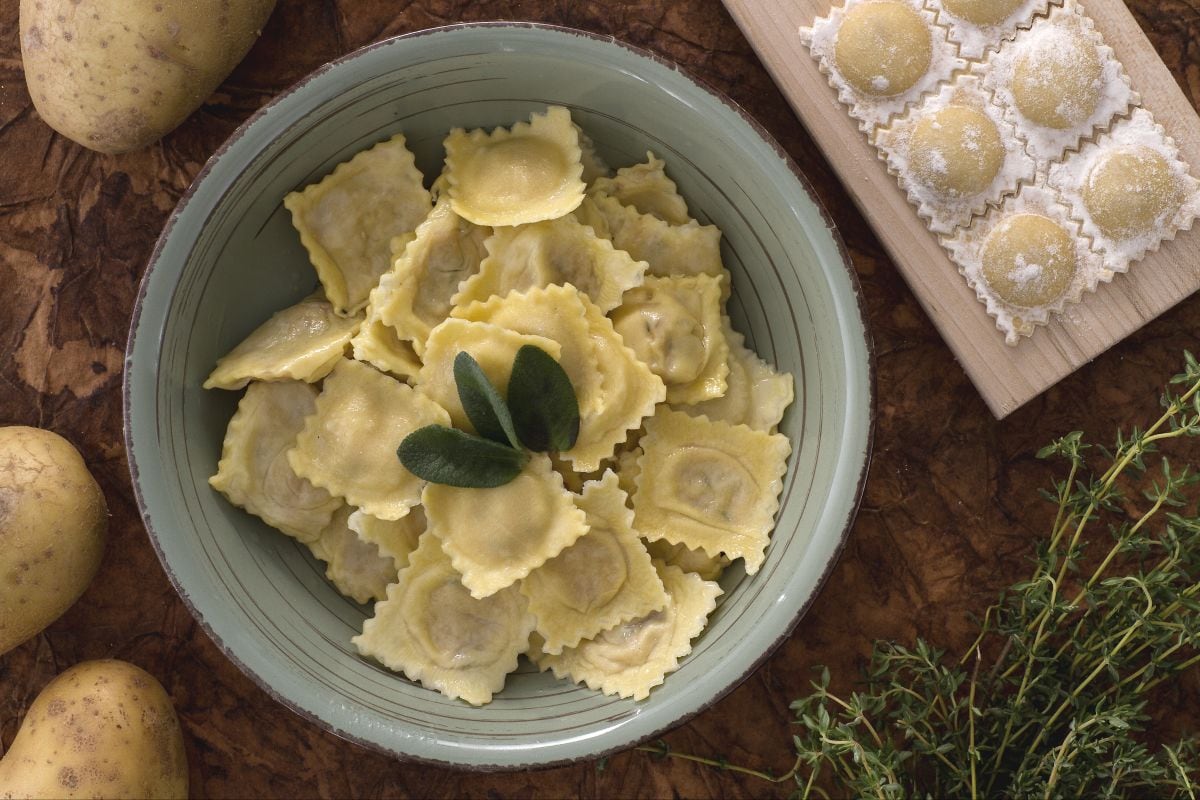Potato and Herb Ravioli with Sauce
- Average
- 1 h 40 min

Ravioli di patate from Tuscany is seriously a tasty example of stuffed pasta. It really brings out the comforting side of Italian cooking. You know, those little pillows are filled with a smooth potato mix—usually with bits of sausage and fresh herbs—all wrapped in a tender and super thin egg pasta. Really, it's the kind of homemade ravioli you’d find on a Sunday table in a Tuscan farmhouse. That warm, creamy filling makes each bite a real treat. People often keep it simple with melted butter and sage on top. Which is great, as it allows the rich flavor of the potato ravioli to shine without anything getting in the way. But if you’re in the mood for something different, try a hearty ragù or a bright tomato sauce with basil. Gives it a whole new feel and makes it even more inviting.
And here's the thing, what's really cool about this ravioli recipe is the room for experimentation, just like cooks do all across Italy. In some Tuscan towns, you might find a version where the moist potato filling is mixed with cheese or a hint of nutmeg for a little kick. Honestly, during holidays, these ravioli often make an appearance. Served with crusty bread and maybe a glass of local red wine—seriously good. No matter the twist, you’ll notice that the pasta remains delicate and a bit golden around the edges, which really really helps the filling be different. People love that balance of soft insides and slightly crisp outside when it’s cooked just right. Whether you keep it classic with sage or explore other ravioli sauce ideas, making ravioli at home turns a simple meal into something special.
Plus, with so many regional takes on Italian ravioli, it’s easy to see why these little pasta pockets are a favorite among traditional Italian recipes. The versatility and rich flavors make them a staple, ensuring that every serving is both comforting and delicious. Really, you can't go wrong.
You might also like:

To prepare the potato ravioli, start by making the egg pasta. You can refer to the procedure from the Cooking School: Homemade pasta (sheets and shapes). In the bowl of a stand mixer, sift the flour 1 and add the eggs 2. Mount the K-beater and mix at medium-high speed to create a homogeneous and soft dough 3.

Then transfer the dough to a work surface or a cutting board and form a ball. Wrap it with plastic wrap 4 and place it in the refrigerator for at least an hour. In the meantime, prepare the filling: boil the potatoes in a large pot 5 for about 15-20 minutes or until cooked. To facilitate cooking, you can also cut the potatoes in half. While they cook, peel two garlic cloves and place them in a small pan with oil 6.

Remove the casing from the sausage by gently cutting it. Add it to the pan 7 and cook for about 15 minutes or until well browned, turning the sausages on all sides 8 to cook evenly. When well browned, turn off the heat and remove the garlic cloves 9.

When the potatoes are cooked, drain them 10 and let them cool slightly. Then transfer them to a cutting board to peel, using a kitchen towel or cloth to avoid burning yourself 11. Once peeled, slice them and place them in a blender. Add a pinch of salt and the roasted sausage pieces 12.

Add parsley 13, mint leaves 14, and thyme 15 to the other ingredients,

then also add chives 16 and a grating of nutmeg 17. Blend until you have a smooth cream, then add the grated Grana Padano cheese 18. Blend until creamy and homogeneous.

Transfer the filling to a small bowl 19 and keep it cool. Meanwhile, after the necessary time, take the egg pasta ball from the refrigerator, divide it in half, and roll out one half with a rolling pin, then use a pasta roller to make a very thin sheet 20. Flour a small ravioli mold 21 (if you don't have one, you can simply lay the sheet on a surface)

spread the sheet over the mold 22 and trim the excess dough with a small knife (23-24),

then take the bowl with the filling and fill a piping bag using a spatula 25. Place a dollop of filling in each indentation of the mold 26 until all are filled 27.

Brush the surface of the sheet around the filling 28. Then roll out the other half of the egg pasta and place it over the filling 29. Press lightly with your fingers 30 to adhere the two sheets.

Then, using a fluted pastry cutter, trim the edges to create the ravioli (31-32). Place the ravioli on a tray lined with a lightly floured kitchen cloth 33.

Fill a pot with water, salt to taste, and bring to a boil. While the water heats, in a large pan, melt the butter over very low heat 34. Add the sage leaves 35. Let the sage wilt for a few moments. Meanwhile, when the water boils, cook the ravioli 36: 1-2 minutes will suffice (they will be done when they begin to float to the surface).

Then drain them using a slotted spoon 37 and place them directly in the pan with butter and sage 38. Stir and sauté for a few moments, then turn off the heat and serve the potato ravioli hot 39!